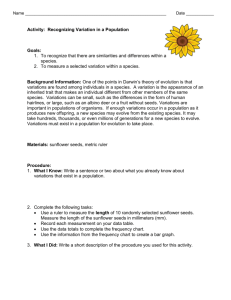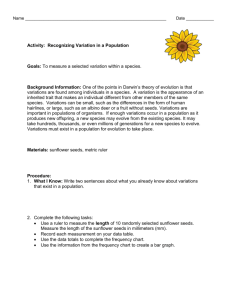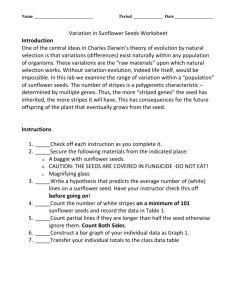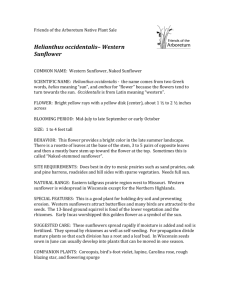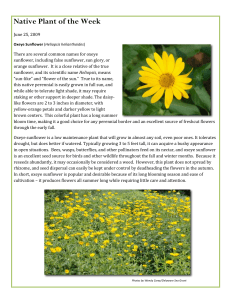Euroflor - كلية الزراعة
advertisement
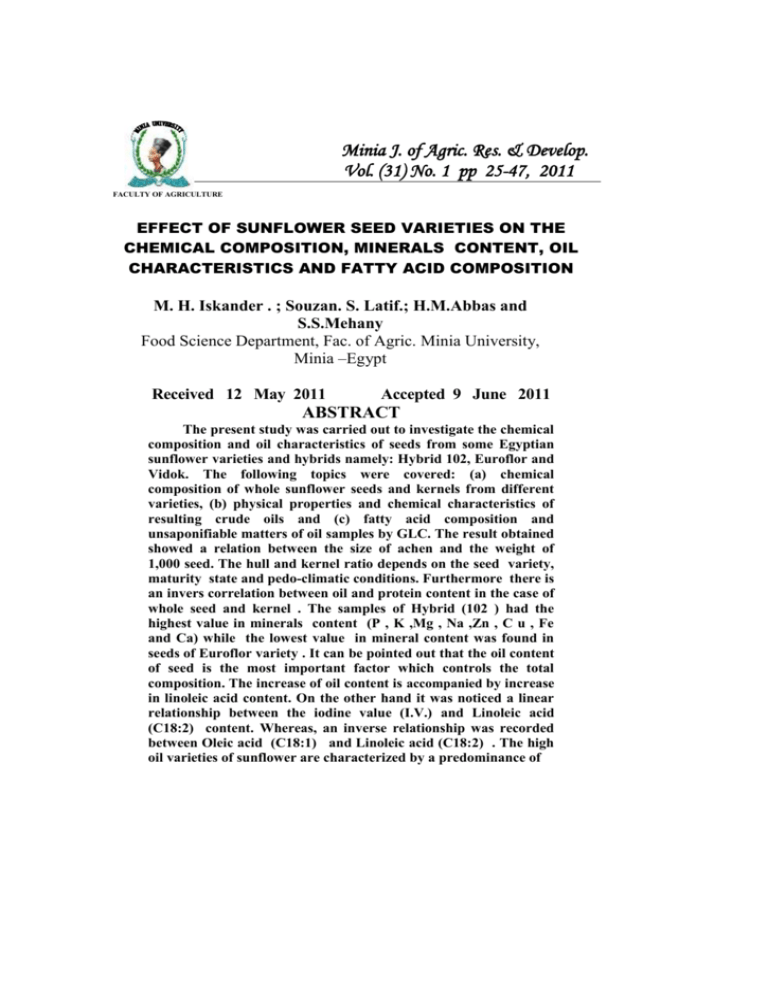
Minia J. of Agric. Res. & Develop. Vol. (31) No. 1 pp 25-47, 2011 FACULTY OF AGRICULTURE EFFECT OF SUNFLOWER SEED VARIETIES ON THE CHEMICAL COMPOSITION, MINERALS CONTENT, OIL CHARACTERISTICS AND FATTY ACID COMPOSITION M. H. Iskander . ; Souzan. S. Latif.; H.M.Abbas and S.S.Mehany Food Science Department, Fac. of Agric. Minia University, Minia –Egypt Received 12 May 2011 Accepted 9 June 2011 ABSTRACT The present study was carried out to investigate the chemical composition and oil characteristics of seeds from some Egyptian sunflower varieties and hybrids namely: Hybrid 102, Euroflor and Vidok. The following topics were covered: (a) chemical composition of whole sunflower seeds and kernels from different varieties, (b) physical properties and chemical characteristics of resulting crude oils and (c) fatty acid composition and unsaponifiable matters of oil samples by GLC. The result obtained showed a relation between the size of achen and the weight of 1,000 seed. The hull and kernel ratio depends on the seed variety, maturity state and pedo-climatic conditions. Furthermore there is an invers correlation between oil and protein content in the case of whole seed and kernel . The samples of Hybrid (102 ) had the highest value in minerals content (P , K ,Mg , Na ,Zn , C u , Fe and Ca) while the lowest value in mineral content was found in seeds of Euroflor variety . It can be pointed out that the oil content of seed is the most important factor which controls the total composition. The increase of oil content is accompanied by increase in linoleic acid content. On the other hand it was noticed a linear relationship between the iodine value (I.V.) and Linoleic acid (C18:2) content. Whereas, an inverse relationship was recorded between Oleic acid (C18:1) and Linoleic acid (C18:2) . The high oil varieties of sunflower are characterized by a predominance of M. H. Iskander et al. Linoleic acid (C18:2) over Oleic acid (C18:1) . The percentage of hydrocarbon were found to be 21.41% , 30.51% and 47.04%of unsaponifiable matter for Euroflor , Vidok and Hybrid (102) respectively.Where total sterol ranged from 52.96% to 78.59% of the unsaponifiable matter. Whereas fraction β-stosterol was the major sterol followed by stigmasterol and campsterol. INTRODUCTION Oil seeds are widely used for the production of vegetable oils and the remainder meals are rich in protein dietary, fibers and carbohydrates. The major parts of oil seed meals are consumed by animal and poultry feeding. Besides, large amount of edible oils used in socalled convenience food such as potato chips, roasted nuts, popcorn and many others. From the nutritional point of view, oils and fats are a structural component of the membranes, which enclose living cells. (Swern, 1979 and Lawson, 1995) In Egypt, the production of vegetable oils is not sufficient to provide the people with edible oils. The country’s policy is directed towards increasing domestic production of different oil crops to overcome being largely dependant on imports of edible oils. Attempts are given to improve the cropping pattern, intensify the cropping system, reclamation and cultivation of desert lands, improvement, development of irrigation water and increasing availability of high seed quality together with agricultural imputes at fair prices Iskander et al., (1986),and (1989). The sunflower seed may be dehulled and eaten without processing. The dehulled seed may be roasted in oil and salted, or used as nutmeats and in candy, salads and bakery products Robertson, (1972). Sunflower oil is a high quality oil for cooking and salad oil uses. In Europe, it has been used extensively in shortening and margarine. The oil is unusually good for frying foods, where a liquid oil with high smoke point is desired. In addition, sunflower oil with higher levels of Linoleic acid, i.e., highly polyunsaturated, is desired for the soft margarine and coating industries, (UNIDO, 1977 and Egan et al., 1981). Traditional sunflower varieties -26- Characteristics of sunflower generally produce oils which have high levels of Linoleic acid and low level of oleic acid, characteristics which have been associated with health problems. To overcome these negative health associations, newer sunflower varieties have been developed with different oil compositions ( Honda et al., 2005). The present work was carried out on some new sunflower seeds varieties namely : Vidoc , Euroflor and hybrid 102 in an attempt to study the following points: (a) the gross chemical composition of whole sunflower seeds and kernels , (b) the physical properties ,chemical characteristics , fatty acid composition and the minor constitutes of the crude oil extracted from sunflower seeds. MATERIALS AND METHODS Materials:Sunflower seeds:Three different new varieties and hybrids of sunflower seeds namely: Hybrid 102, Euroflor and Vidok were selected in this investigation and obtained from the Field Crops Research Institute, (FCRI), Agriculture Research center (ARC) at Abnob-Assiut, Egypt. Sunflower seeds oil:Sunflower oil samples were extracted from the studied seeds by using pure n-hexane according to the method described in AOCS (1998). The oil was dried over anhydrous sodium sulfate, filtered, stored in dark brown bottles then kept at 5 ºC until analysis. Analytical methods:Analysis of sunflower seeds:Moisture ,crude oil , crude protein (T.N.x 6.25) , crude fibre and ash were determined according to the method of the AOAC (2000). Total carbohydrates were estimated (as glucose%) after acid hydrolysis and spectrophotometrically determined using phenol, sulphoric acid reagent according to the method of Dubois et -27- M. H. Iskander et al. al.,(1956). All determinations were performed triplicates and the means were reported. Minerals contents phosphorus (P) , potassium (K), magnessium (Mn), sodium (Na), zinc (z), cupper (Cu), iron (Fe) and calcium (Ca) were determined according to the methods described in AOAC (2000). Calcium and magnesium contents were determined using Double Beam Atomic Absorption .Potasium and sodium contents were determined by flam photometer method , Coring 410 ( coring Limited Halested Essex England UK) Iron and zink were determined by spectrophotometry 902 GBC and phosphorus by using visible spectrophotometer PU 8650 (Pye Unicam , England). Analysis of sunflower seed oil:Physical properties:All the samples were analyzed according to the AOCS (1998), the Specific gravity (Sp.Gr.) for sunflower seed oil samples was determined at 25/25ºC according to Cc 10-25, the refractive index (R.I.) was tested according to Cc7-25 and the color of oil samples was determined by the color Wesson method using Lovibond glasses and calibrated according to Cc 13b-45. An automatic refractometer was used and the results were standardized at 25ºC. Chemical Characteristics:The investigated samples was examined according to the method described in the AOCS (1998) ,the acidity of the samples was examined according to Cd-3a-63 and was calculated in terms of acid value (A.V) as mg. KOH / g. oil sample, the iodine value (I.V) was determined by the Hanus method as described in the Cd 1-25,the saponification value (S.V.) was investigated as outlined in the Cd 3-25, and peroxide value (P.V.)as mg of koh/ saponify 1g oil was tested according to Cd8-53. The PV was reported as milliequvalents of peroxide per Kg sample. -28- Characteristics of sunflower Unsaponifiable matters of oil:Separation of unsaponifiable matters:The unsaponifiable matters were separated from the oil samples after saponification according to the method outlined in the AOCS (1998). Identification of the unsaponifiable matters components by gas liquid chromatography :The unsaponifiable matters (hydrocarbons and sterols compounds) were identified by using a Hewlett Packard gas chromatography model 5890 equipped with a flame ionization detector in the presence of nitrogen as carrier gas. The separation was carried out at 100-280 ºC (temperature rate 5ºC/min.) followed by 20min. at 280 ºC. The column used for separation was 25 x 0.2 m L.D. fused silica capillary column coated with dimethyl silicon fluid. The injector and detector temperatures were 250 and 300 ºC, respectively. The nitrogen, hydrogen and air flow rates were 20, 30 and 400 ml/min., respectively. The sample size was 1µL. The authentic samples of hydrocarbons (C12 ; C13 ; C14 ; C15 ; C16 ; C17; C18;C19; C20 ; C21 ; C22; C23 ; C24 ; C25 ; C26;27 ; C28; C30 and squalene) and sterols (cholesterol, campestrol, stigmasterol and B-sitosterol) were also injected under the same conditions and the relative retention times (R.R.T) were calculated. The peaks area were identified by comparing their retention times with those of standardized under the same conditions. Retention times were deermined by using Hewlett Packared 3392 integrator. Fatty acid compositions:The composition of the fatty acid s was performed by gas liquid chromatography (GLC) . The methyl esters of fatty acids were prepared as described in AOCS (1998). The fatty acid methyl esters were separated by using a Hewlett Packard GLC (model 5890) equipped with a dual flam ionization detector (FID). The coiled glass column (1.6m × 4mm) was packed with diatomite (00-120 mesh) and coated with 10% Di–ethylglyco succinate (DEGS). The operation was carried isothermally at column temperature 170ºC, detector and injection -29- M. H. Iskander et al. temperatures were 300ºC and 250ºC, respectively. The nitrogen, hydrogen and air flow rates were 30, 30 and 330 ml. /min., respectively. The sample size (1μL) of fatty acid methyl esters were dissolved in chloroform was injected into the column using a Hamilton microsyring. chart speed was 2 cm./ min. Peak areas were measured using Hewlett Packared 3392 integrator. RESULTS AND DISCUSSION Chemical composition of sunflower seeds :1-Gross chemical composition of whole seed (achene):The major components of whole sunflower seeds (achene) and kernels of Hybrid (102), Euroflor and Vidok were studied. Weight of 1000 seeds, % kernel, % hull, % ash, % oil, % protein, % fiber and % of carbohydrates were determined and the results are shown in Tables (1) and (2). The results represented in this study Table (1) indicated that the weight of 1000 seeds was 43.10g. for Hybrid (102), 52.00g. for Euroflor and 56.30g. for Vidok. The differences in the weight of 1000 seeds may be due to the variations in the degree of seed development and the cultivation zone .On the other hand, these differences could be explained by the fact that for achenes of oilseed varieties exist a relationship between the size of achene and weight of 1000 seeds. Such results are in reasonable agreement with those of, Earle, et al.,(1968)) Biino and Carlisi,. (1969).and Eskandar, and Banu, (1982). .As for the kernel percentage of different varieties and hybrids, the data obtained in Table (1) indicated that the kernel percentage was 71.20, 71.44 and 74.00 for Hybrid (102); Vidok and Euroflor, respectively. On the other hand, results in Table (1) showed the following values for hull percentage: 26.00; 28.56 and 28.80 for Euroflor, Vidok and Hybrid (102), respectively.These results revealed that both percentage of kernel and hull depended on the seed variety, the stage of maturity, the cultivation zone and the purpose of seed production (for confections and birdseed or oil). Such results agree with those reported by Biino and Carlisi,. (1969). , Eskandar, and Banu, (1982). and Raymond,et al.,(1991). -30- Characteristics of sunflower Furthermore, the data in Table (1) indicated that the moisture content was 4.83, 4.70 and 4.18 % in Hybrid (102), Euroflor and Vidok, respectively. Also, the results in the same Table showed that the dry matter percentage for the studied varieties and hybrids was 95.17 , 95.30 and 95.82 % in Hybrid (102); Euroflor and Vidok , respectively. These results are in the same trend with those reported by (Darwish,et al.,(1975),Hafiz ,et al.,(1993), and Francis,(2000).As for ash content, the results represented in this study (Table, 1) showed a little variation in the ash content between different varieties and hybrid. The following values were found: 4.25; 4.28 and 4.40 % (on DB) for Hybrid (102), Euroflor and Vidok, respectively. Similar results were obtained by Pellet, and Shadarevian, (1970). Table 1: Proximate chemical composition (*) of whole sunflower seeds (achene) of three cultivars Variety and hybrid Analysis Hybrid (102) Euroflor Vidok 43.10 71.20 28.80 4.83 95.17 4.04 52.00 74.00 26.00 4.70 95.30 4.08 56.30 71.44 28.56 4.18 95.82 4.22 W.B D.B W.B 4.25 41.16 4.28 38.97 4.40 44.74 Oil % D.B W.B 43.25 23.44 40.89 25.88 46.69 16.02 Protein (N x 6.25), % D.B W.B 24.63 18.14 27.16 17.13 16.72 23.52 Fiber % D.B W.B 19.06 8.39 17.97 9.24 24.55 7.32 D.B 8.81 9.70 7.64 Weight of 1000 seeds, (g) Kernel, % Hull, % Moisture % Dry matter % (**) Ash % Carbohydrates as glucose % (***) (*) Each figure give in this Table is a mean of three determinations. (**) Calculated from weight of kernel and hull, to avoid inclusion of empty or wormy achens. (***) Including soluble and non-soluble sugars. -31- M. H. Iskander et al. On the basis of total oil content, it was observed the following values: 43.25, 40.89 and 46.69 % (on DWB) for whole, sunflower seeds (achene) of Hybrid (102), Euroflor and Vidok, respectively. Generally, it can be observed that all the studied sunflower seed varieties had high oil content ranging from 40.89 and 46.69 % (on DB). These results are in accordance with those reported by, Morrison,(1983) and Fadia,(2004) . Concerning the protein content (DB), the studied varieties and hybrids can be arranged in the following ascending order : Vidok (16.72 %) ; Hybrid-102 (24.63 %) and Euroflor (27.16 %). These results show the existence of an inverse relationship between oil content and protein content. Such results are in good accordance with those recorded by, Pellet, and Shadarevian, (1970) Robertson, et al., (1971), Morrison,(1983) , Praveena, et al., (2000) and Fadia (2004). As for the fiber content (DB) in different sunflower varieties and hybrids used in this study, it was noticed from Table (1) that the fiber content (DB) in whole sunflower seeds ranged from 17.97 % (in Euroflor variety) to 23.52 % ( in Vidok variety). This difference in fiber content could be attributed to variations in the seed varieties which detemine hull proportion and the fiber content. These results are in general agreement with those reported by Francis,(2000).The carbohydrate contents (soluble and nonsoluble sugars) were: 8.81 % (on DB for Hybride, 102); 9.70 % (for Euroflor variety) and 7.64 % (for Vidok variety) (Table, 1). Such results are in the same trend with those reported by Fadia (2004) 2- Gross chemical composition of sunflower seed kernel:Data in Table (2) indicated that the sunflower seed kernel of Vidok variety had the highest value of moisture content (5.47 %) followed by Hybrid (102) 3.94 % whereas the lowest value of moisture content was found in Euroflor variety (3.03 %). In addition, the data recorded in Table (2) revealed that the dry matter was ranged between 94.53 % for Vidok variety to 96.97 % for Euroflor variety. These results are in the same trend with those reported by Hafiz, et al., (1993). -32- Characteristics of sunflower As for ash content, the results obtained in Table (2) show that the ash content (DB) of sunflower seeds kernel varities was in the range of 4.67 % ( for Euroflor variety) and 5.80 % ( for Hybrid, 102) with a mean of 4.74 %. These results are in coincide acne with those obtained by Saeed and Cheryan, (1988). . On the basis of oil content (DB), the following values were noticed: Hybrid, 102 (46.91 % ), Euroflor (42.48%) and Vidok (51.24 %). On the other hand, it was observed the following values for the protein content: 23.92 %, 29.69 % and 14.64 % (on DB) in Hybrid (102), Euroflor, and Vidok, respectively. Such results agree with those reported by Pellet, P. L. and Shadarevian, S. (1970). As for fiber content (DB), the following results were obtained : Hybrid-102 (16.17 %); Euroflor (15.48 %) and Vidok (22.58 %). Such findings agree with those reported by Bau, et al., (1983) . Concerning the content of carbohydrates (DB), the results represented in Table (2) showed the following values: Hybrid-102 (7.20 % on DB); Euroflor (7.68 %) and Vidok (6.28 %). These results are in general agreement with those recorded by. Hafiz,Et al.,(1993) and Fadia (2004). Table 2: Proximate composition (*) of sunflower seeds kernel of three cultivars Analysis Moisture % Dry matter % W.B Ash % Oil % Protein (N x 6.25), % Fiber % Carbohydrates % (**) Variety and hybrid Hybrid (102) Euroflor 3.94 3.03 96.06 96.97 5.57 4.53 Vidok 5.47 94.53 4.97 D.B W.B 5.80 45.06 4.67 41.19 5.26 48.44 D.B W.B 46.91 22.98 42.48 28.79 51.24 13.84 D.B W.B 23.92 15.53 29.69 15.01 14.64 21.34 D.B W.B 16.17 6.92 15.48 7.45 22.58 5.94 D.B 7.20 7.68 6.28 (*) Each figure give in this table is a mean of three determinations. (**) Including soluble and non-soluble sugars. -33- M. H. Iskander et al. 3 – Mineral content of sunflower seeds :The minerals content, i.e. P, K, Mg, Na, Zn, Cu, Fe and Ca, in the three cultivars of sunflower seeds ( whole seeds and kernel) were determined and the results are embodied in Tables (3) and (4). Generally, it can be observed that the samples of Hybrid-102 (either whole seeds or kernel) had the highest value of all determined minerals followed by samples of Vidok and the lowest values were found in Euroflor samples. Concerning phosphorus (p), the results recorded in Tables (3) and (4) indicated that it ranged between 730.00 and 1900.00 mg / 100g for achene and between 700.00 and 730.00 mg / 100g for sunflower seed kernel. These results are in coincid with those obtained by Ndoreyaho, et al., (1991), and Ensminger,et al., (1965) but they were higher than those reported by Hafiz et al (1993) This differences might be due to variation in the seed variety, stage of maturity and the cultivation zone. Regarding the potassium element (K), it was evident from the results in Tables (3) and (4) that it represented the predominant inorganic constituent in sunflower seeds. These results are in the same trend with those reported by Watt and merill (1975). Table 3 : Mineral content of whole sunflower seeds (achene) of three cultivars (mg /100g)* P K Mg Na Zn Cu Fe Ca Hybrid –102 1900.00 2860.00 1180.00 178.90 12.80 1.63 1.18 36.60 Euroflor 730.00 1530.00 1170.00 .00 8.90 0.69 0.51 33.10 Vidok 750.00 2820.00 1175.00 176.30 11.00 1.04 1.08 34.50 *Results are the mean of triplicate determinations and calculated on DB. -34- Characteristics of sunflower This differences could be attibuted to the seed variety as weel as cultivation zone. With regard to other minerals i.e. magnesium, sodium, zink, cupper, iron and calcium, in the whole sunflower seeds (achene) , the results in Table (3) showed the following values: magnesium ( 1170 - 1180 mg / 100g ), sodium ( 166.00 178.90 mg / 100g) , zinc (8.90 - 12.80 mg / 100g) ; cupper (0.69 1.63 mg / 100g ); iron ( 0.51 -1.18 mg / 100g) and calcium ( 33.10 - 38.60 mg / 100g) . For sunflower seed kernel samples, the data in Table (4) showed the following values: magnisum ( 970 - 1060 mg / 100g) ; sodium ( 140 -154 mg / 100g ); zinc ( 8.60 - 12.00 mg / 100g) ; cupper (0.60 - 1.09 mg / 100g) ; iron ( 0.33 -0.46 mg / 100g) and calcium ( 15.86 -27.80 mg / 100g) . Similar results were obtained by Watt, and. Merill, (1975) and Ndoreyaho,et al., (1991). It is noteworthy to mention that the sunflower seeds can be considered as a good source of minerals and for this reason the sunflower meal can be used in animal nutrition. These results are in the same trend with those reported by Ensminger, et al., (1965). They reported that sunflower meal can be considered as a good source of calcium and phosphorus and it contained 31 % more than the normal source of iron . Table 4 : Mineral content of sunflower seeds kernel of three cultivars (mg /100g)* p K Mg Na Zn Cu Fe Ca Hybrid –102 730.00 2190.00 1060.00 154.90 12.00 1.09 0.46 27.80 Euroflor 700.00 1500.00 970.00 140.00 8.60 0.60 0.33 15.86 Vidok 720.00 1770.00 1050.00 147.30 8.90 0.90 0.38 25.30 *Results are the mean of duplicated determinations and calculated on DB. -35- M. H. Iskander et al. Physico-chemical characteristics of crude oil extracted from different varieties of sunflower seeds:The physico-chemical characteristics of the sunflower seed oil extracted from different varieties and hybrids are presented in Table (5). The results obtained indicated that the specific gravity at 25 /25 ºC ranged from 0.9170 (Euroflor) to 0.9176 (Hybrid –102) with an average of 0.9173. On the basis of refractive index at (25 ºC), the following values were found: Euroflor (1.4735); Vidok (1.4739) and Hybrid –102 (1.4732). Such results are in reasonable agreement with those obtained by Fadia,(2004). Oil color is another indicator of quality. The results obtained in this study (Table 5) indicated that the color of oil extracted from Vidok variety was darker (higher) than the color of the other oil samples. This difference of the color is due to the natural pigment content which passes from oil bearing material into the extracted oils, as well as due to the secondary pigments which presence is due to the treatment condition of the bearing material. Seed stored for prolonged periods under unfavourable temperature and moisture conditions and exposed to air- oxidation yields darker colored oils than fresh seed.These results agree with those reported by Rich (1967). On the basis,the acid value, the data in Table (5) indicated that the acid value (mg KOH / g oil) of laboratory extracted oils was in the range of 0.31 (Euroflor variety) and 0.93 (Hybrid-102) with a mean of 0.62. The differences in acid value may be due to the conditions during ripening of the seeds and conditions of harvesting and storage as well as conditions during processing. Similar results were obtained by Swern,(1979), Concerning the iodine value (g iodine saturate 100g oil), the results obtained in Table (5) indicated that the iodine value of sunflower oil samples under investigation were 114.13; 103.46 and 118.54 for Euroflor, Vidok and Hybrid (102), respectively. This is to be expected since the high iodine value could be attributed to the high content of linoleic and linolenic. Generally, it can be observed that the variation in iodine value could be attributed to the variation in -36- Characteristics of sunflower polyunsaturated fatty acid contents. These results are in accordence with those reported by Fadia,(2004). As for the saponification value (mg KOH saponify g oil), results in Table (5) revealed that the sunflower seed oil extracted from Euroflor variety gave the highest saponification value (192.00) while, the lowest value (188.00) was recorded for sunflower seed oil extracted from Vidok variety. These differences could be attributed to the formation of new fatty acids that differ in their molecular weight. In general, the high saponification value indicates lower molecular fatty acids. These results are in harmony with those reported by Weiss (1970) and Francis (2000). Table 5: Physico - chemical characteristic of crude sunflower oils extracted from different varieties and hybrids . Variety and hybrid Characteristic Specific gravity at 25 / 25°C ( Sp. Gr.) Refractive index at 25°C ( R. I. ) Color : Lovibond (Y / R ), 1 inch cell Acid value ( A.V. ) Iodin value (Hanus),(I.V). Saponification value (S.V). Peroxide value (P.V.). Unsaponifiable matter (%) Euroflor Vidok Hybrid (102) 0.9170 1.4735 35 / 4.3 0.31 114.13 192.00 0.75 1.10 0.9174 1.4739 35 / 6.1 0.51 103.46 188.00 1.15 1.02 0.9176 1.4732 35 / 5.1 0.93 118.54 191.00 1.23 0.97 * Each figure given in this table is a mean of three determination. Oxidative rancidity is the principal problem in fats and oil, peroxide value (as indicator of primary oxidation) is employed in this study to determine the extent of oxidation caused in the investigated oils. Data in Table (5) indicated that the peroxide value was 0.75, 1.15 and 1.23 meq peroxide /kg sample in Euroflor, Vidok and Hybrid (102) oil samples, respectively. The results indicated also that the peroxide values of all oil samples used in this study were below the permissible limits of 10 milliequivalent of peroxide / kg sample according to E.O.S (1993). -37- M. H. Iskander et al. The unsaponifiable matter (includes hydrocarbons, sterols, vitamins and pigments compounds) usually plays an important role in the oil stability. It is obvious from the results in Table (5) that the oil samples under investigation had comparable content of unsaponifiable matter (1.10 %, 1.02 % and 0.97 % for oil samples extracted from Euroflor, Vidok and Hybrid –102, respectively). These finding are in the same line with those reported by Van Oss (1975) . Fatty acid composition:The results presented in Table (6) demonstrated the fatty acid composition of sunflower oil extracted from different varieties and hybrids. The data obtained by using G.L.C. pointed that the major fatty acids were oleic and linoleic which represented 37.40 – 48.58 % and 34.97 – 49.16 %, respectively, followed by palmitic acid (7.84 – 9.53 %), stearic acid (3.52 – 4.55 %), arachidic acid (0.22 – 1.43 %), behenic acid (0.65 – 0.83 %) and linolenic acid which it ranged between 0.41 % and 0.45 %. In addition, the data given in Table (6) indicated that the total amount of saturated fatty acids (TSFA) ranged between 13.03 and 16.01 % while the total amount of unsaturated fatty acids (TUFA) ranged from 83.99 to 86.97 %. These results obtained herein are in general accordance with those reported by Osorio,et al.,(2006). Generally, it can be concluded from the results in Table(6) that: Vidok variety contains the highest percentage of oleic acid (48.58 %), while Euroflor variety contains the lowest percentage (41.52 % ). Hybrid (102) contains the highest percentage of linoleic acid (49.16 %) while, Vidok variety contains the lowest percentage (34.97 %).There were little differences in amounts of palmitic acid and stearic acid between the investigated oils. Small percentages of arachidic, behenic and linolenic acids were present in the examined seed oils. Sunflower Hybrid (102) contains the lowest percentage of total saturated fatty acids (13.03 %) while Vidok variety contains the highest percentage (16.01%). On the other hand, Vidok variety contains the lowest percentage of TUFA (83.99 %) while, Hybrid (102) contains the highest percentage (86.97 %).In general, there was a -38- Characteristics of sunflower wide variation among the fatty acids contents specially oleic and linoleic acids in all varieties and hybrids of sunflower. These differences may be due to the origin of varieties, the genetic diversity, the stage of maturity, the cultivation zone and the purpose of seed production (for confections and birdseed or oil). Such results agree with those reported by Biino, and Carlisi, (1969) and Fadia, (2004). Table 6: Fatty acid composition of sunflower seed oil extracted from different varieties and hybrids (% of total fatty acids) Varieties and hybrid Euroflor Vidok Hybrid–102 Fatty acids % Saturated fatty acids (SFA) Palmitic C16 : 0 Stearic C18 : 0 Arachidic C20 : 0 Behenic C22 : 0 7.84 04.55 00.22 00.83 09.53 04.28 01.43 00.77 08.33 03.52 00.53 00.65 13.44 16.01 13.03 Unsaturated fatty acids (UFA) Oleic C18 : 1 Linoleic C18 : 2 Linolenic C18 : 3 41.52 44.59 00.44 48.58 34.97 00.41 37.40 49.16 00.45 Total unsaturated fatty acids (TUFA) 86.56 83.99 86.97 TUFA : TSFA 6.44 05.25 06.67 01.07 00.72 01.31 Total saturated (TSFA) fatty C18 : 2 : C18 : 1 acids Many investigations Mc–Gandy, and Egsted, (1975) and Vergroesen, and Gottenbos, (1975) reported that the diet which has a high content of linoleic acid and low content of saturated fatty acids play an important role in preventing or inhibition of -39- M. H. Iskander et al. atherosclerotic disease by lowering the blood cholesterol effect. In addition, FAO / WHO (1977) reported that the high content of linoleic acid not only lowers blood cholesterol concentration but also the tendency of the platelets was significantly decreased. On the other hand, Haumann, (1998).showed that the saturated fatty acids with 16 or fewer carbon atoms raise serum cholesterol levels. In contrast, dietary, stearic acid, on 18 carbon atom saturated fat, does not effect. So, He thought that this may be related to stearic acid which has a relatively high melting point. The results recorded in Tables (5 and 6) showed also, a linear relation between iodine value and linoleic acid content. At the same time, it was observed an inverse relationship between oleic content and linoleic acid content. On the other hand, the results indicated that the high oil varieties of sunflower are characterized by a predominance of linoleic acid over oleic acid, increases in the oil content of the sunflower seed were accompanied by increased in linoleic acid content. Such results agree with those reported by Cummins et al.,(1967) . Unsaponifiable matters :The results present in Table (7) showed the percentage of hydrocarbons and sterols in sunflower seed oil from different varieties and hybrids.. Euroflor variety contains the lowest percentage of hydrocarbon (21.41 %) while Hybride (102) contains the highest percentage (47.04 %). Data present in Table (7) showed that the total sterols of the unsaponifiable matters of sunflower varieties ranged from 52.96 % to 78.59%. Hybrid (102) contains the lowest percentage (52.96 %) while Euroflor variety contains the highest percentage (78.59).The β – sitosterol was the major sterol fraction of total sterol followed by stigmasterol and campsterol. -40- Characteristics of sunflower Table 7: Unsaponifiable matters (hydrocarbons and sterols) of sunflower oil extracted from different seed varieties and hybrids. Euroflor Vidok Hybrid –102 ----0.40 ----2.13 ----0.50 ----2.00 1.45 0.84 4.68 1.20 1.04 1.75 4.12 1.30 ----0.20 ------------0.10 ----0.82 1.85 1.53 1.36 3.71 1.27 1.30 17.24 1.13 ----5.13 7.97 6.02 ----1.80 ----1.75 1.31 2.75 3.30 4.20 3.40 1.90 6.36 1.15 Total hydrocarbons B – sterols Campsterol Stigmasterol β –sitosterol 21.41 30.51 47.04 8.73 13.95 55.91 10.55 16.30 42.64 6.03 12.80 34.13 Total sterols 78.59 69.49 52.96 A- Hydrocarbons n-Dodecane C12 n-Tetradecane C14 n-Pentadecane C15 n-Hexadecane C16 n-Heptadecane C17 n-Octadecane C18 n-Nonadecane C19 n-Eicosane C20 n-Uncosane C21 n-Docosane C22 n-Tricosane C23 n-Tetracosane C24 n-Pentacosane C25 n-Hexacosane C26 n-Octacosane C28 n-Triacontane C30 (-) Not detected The percentage of β – sitosterol ranged from 34.13 % to 55.91% in different varieties and hybeids. Hybrid (102) contains the lowest percentage of β – sitosterol, while Euroflor variety contains the highest percentage. The amount of stigmasterol was ranged from 12.80 % to 16.30 %. Hybrid (102) contains the lowest amount while Vidok variety contains the highest amount. The -41- M. H. Iskander et al. value of campesterol was ranged from 6.03 % to 10.55 %. Hybrid (102) contains the lowest value, while Euroflor variety contains the highest value. These results are in the same line with those found by Itoh,et al.,(1973), and E.O.S. (1993) who mentioned that the vegetable oil sterol are known collectively as phytosterols. Two of the most common phytosterols are β – sitosterol and stigmasterol. These results also, are in accordance with those reported by Vlahakis, and Hazebroek, (2000). REFERANCES AOCS (1998). Official and Tentative Methods of the American Oil Chemists Society (5th ed.) AOCS, 35 East Warker Drive, Chicago, Luinois,USA AOAC (2000). Official Method of Analysis. Association of Official Ana-lytical Chemists (17th ed.) Published by Association of Official, Analytical Chemists, Arlington, Virginia, USA. Bau, H.M. Mohtodi-Nia, D.J. Mezean, L. and Debry, G. (1983) Preparation of colorless sunflower protein products. Effect of processing on physicochemical and nutritional properities.J.Am.Oil Chem.Soc. 60:1141 Biino, L. and Carlisi, E. (1969).Variation of the oil content in groundnut an sunflower seeds in relation to their degree of development Atti Soc. Peloritana Sci. Fis.Mat.Natur, 15(314) p.157 (c.f. chem. Abstr. 78,1973: 1998d) Cummins, D.G. Marion, J.E. Graigmiles, J.P. and Burns, R.E. (1967) Oil content , fatty acid composition and other agronomic characteristics of sunflower introductions J.A.O.C.S .44 :581-582. Darwish, N. El.Nahry, F. and Sabsoura, A.(1975) The nutririve value of local roasted sunflower seeds. Annals of Agric. Sci. Fac. of Agric., Ain Shams Univ. xx:101108. -42- Characteristics of sunflower Dubois, M. Gilles, A. Hamilton, J.K. Robers, P.A. and Smith, F.A. (1956). Colorimetric method for determination of Sugar and related substance. Analyt. Chem. , Vol. 128:350-356. Earle, F. R. Vanetten, C.H. Clark, T. F. and Wolff, I. A. (1968). Compositional data of sunflower seed. J.A.O.C.S .45:876-879. Egan, H. Kirk, R. S. and Sawyer, R. (1981). Pearson’s Chemical Analysis of Foods (8th. ed.). Churchill livingstone, Longman Group Limited. London, New York. Ensminger, A.H. Ensminger, M. E. Konlande, J. E. and Robson J. R. K.,(1965)The Concise Encyclopedia of Food and Nutrition. CRC Press Boca Raton Lodon, Tokyo. P.996. E.O.S. (1993). Egyptian Organization for Standardization, Standards No. 08-0049 for vegetable edible oils. Published by E.O.S. Mininistry of Industry – Cairo, Egypt Eskandar, M.H. and Banu, C.C.(1982). Chemical composition of Roumanian sunflower seeds from different varieties and hybrids. La Rivista Italiana Delle Sostauze Grasse-Vol LIX-95-198. Fadia, H.A.A. (2004).Biochemical studies on some vegetable oils. Ph.D. Thesis in Agric. Sci. (Biochemistry) Fac. of Agric. Cairo Univetsity. FAO / WHO The role of fat in the prevention and treatment of cardio-vascular disease, obesity and diabetes mellitus, Rome, 21-30 September. (1977). Francis, F. J. (2000). Oilseed and vegetable oils. Encyclopedia of Food Science and Technology (2nded) Vol. 3:17451755. John Wiley & Sons. Inc. New York, Singapore, Toronto Hafiz, N. E. Alian, A. H. El-Wakeil, F. A. and Awad. A. A. M. (1993).Biophysical evaluation Studies of some -43- M. H. Iskander et al. sunflower cultivated in Fayoum, Egypt. J. of Food Sci., 21:263-277. Haumann, B. F. (1998) Stearic acid : a different saturated fatty acid.INFORM 9 (3) : 202 – 207 .Honda, Y. Mukasa, Y. and Suzuki, T.(2005). Traits of NuSun TM varieties of sunflower in Hokkaido, Japan. Plant production Science 8(4): 461-464 Iqtidar, A. K. Hamidullah S., Farzana, Y.and Mazhar, A. M.(2000) Seed Yield and fatty acid profile of sunflower hybrids. Sarhad- Journal of Agriculture ; 16(6) : 601-604 Iskander, M. H. Dawood, A.A.and Hatour, F.S. (1986). Effect of storage conditions on the stability and fatty acid composition of sunflower oil. Minia J.Agric. Res. & Dev.8(3): 877-890Egypt Iskander , M. H., Metry S.W. and Hatour , F.S. (1989). Studies on mineral content , free and protein amino acid , oil properties and fatty acid composition of sunflower. Annals of Agric.Sci.Moshtohor 27(1) : 371 -382. Egypt . Itoh, T. Tamura, T. and Malsumoto, T. (1973). Sterol composition of 19 vegetable oils. Journal of the American oil chemists’ Society 50(4): 122-125. Lawson, H. (1995) In food oils and fats : technology, utilization and nutrition.Chapman and Hall :New york. Mc – Gandy, R. B. and Egsted, H.(1975). The role of fats in human nutrition. Academic press London. 211-230 Morrison, W. H. (1983)Variation in the wax content of sunflower seed with location and hybrid. J.A.O.C.S 60: 10131014. Ndoreyaho, V. Mukankusi, V. and Norifalise, A. (1991). Some essential minerals and trace element of sunflowere press cake meal. Food policy Trends in Europe. Nutrit-ion, Technology, Analysis and safety, p. 231(1991) (c. f. FSTA 25,3N40, 1993). -44- Characteristics of sunflower Osorio, J. Fernandez, J. M. Mancha, M. and Garces, R.(2006) Sunflower seeds and oil having a high stearic acid co- ntent-UK patent.(c. f. FSTA, 2006). Pellet, P. L. and Shadarevian, S. (1970).Food Composition – Tables for use in the Middel East (second edition). American University of Beirut, Lebanon. Praveena, P. Srinivas, C. V. S. and Nagara, G.(2000) Quality of some Indian sunflower genotypes and utiliza-tion of cake in snack foods. HELLA, 23: 113-120. Raymond, J. V. Inquello, and Azonza, J. L.(1991) The seed proteins of sunflower : comparative studies of cultivars. Phytochemistary, 30(9): 2849-2856. Rich, A. D. (1967). Major factors influence bleaching performance. J. A. O. C. S:41,315. Robertson, J. A. Thomas, J. K. and burdick, D.(1971). Chemical composition of the seed of sunflower hybrids and open pollinated varieties. J. Food Sci. 36:873-876. Robertson, J. A. and Morrison, W. H.(1979). Analysis of oil content of sunflower seed by wide line NMR. J. A. O. C. S. 56:961-964. Robertson, J. A. (1972). Sunflower: America’s Neglected Crop. Journal of the American Oil Chemists’ Socirty 49 (4): 239-244. Swern,D. (1979) Bailey’s Industrial Oil and Fat Products (Vol. 1, 4th Edition). John Wiley & Sons- New York, London, Sydney. Saeed, M. and Cheryan, M.(1988).sunflower protein concentrates and isolates low in polyphenols and phytate J. Food Sci. 53 : 1127-1131. UNIDO,(1977). United Nation Industrial Development Organization 1C15 46.14 Draft World- Wide study on the vegetable and fats Industry 1975-2000. September -45- M. H. Iskander et al. Van Oss, J. F (1975).Materials and technology (vol VIII).(Edible oils and fats, Animal food products, Material resources).Longman, J.H. de Bussy- London Vergroesen, A. J. and Gottenbos, J.J. (1975) The role of fats in human nutrition. Academic Press, London 1- 41. Vlahakis, C. and Hazebroek,J(2000)Phytosterol accumulation Canda, sunflower and soy-bean oils, effects of genetics, planting location and te-mperature. JAOCS, 77 : 49-53. Weiss, T. J. (1970) Food oils and their uses. The Av1 publishing Company, INC. Williams, K. A. (1966). Oils, Fats and Fatty Foods (4 th Ed.). J.and A. Churchill LTD., London Watt, B. K. and. Merill, A. L(1975) “ Sunflower seed protein” In Altschul, A. M. and H. L. wilcke. “New protein foods” pp 394-429.Academic Press 1nc. -46- Characteristics of sunflower تأثير أصناف بذرة دوار الشمس على التركيب الكيماوى ومحتوى المعادن و خصائص الزيت وتركيب األحماض الدهنية منير حنا اسكند ر -سوزان سعد لطيف -حمدي محمد عباس سامية شحاتة مهني قسم علوم األغذية -كلية الزراعة -جامعة المنيا – المنيا -مصر أجريتتت هتتت الدراستتتة لبحتتت التركيتتت الكيميتتتاوي وئصتتتاوت الزيتتت لتتتبع أصناف دوار الشتمس المصترية هجتين 201وايروفلتور وفيتدو وقتد شتمل الدراستة اآلتى ا-التركي الكيماوى لب ور ولت أصتناف مئتل تة لدوارالشتمس -الئصتاوت الطبيعيتتتة والكيماويتتتة للزيتتت النتتتات -تركيتتت ااحمتتتا الدهنيتتتة والمتتتواد ال يتتتر متصتتبنة لعينتتا الزي ت بواستتطة GLCوأظهتتر النتتتاو المتحصتتا عليهتتا العالقتتة بتين حجتا البت ور الزيتيتة ووزن االتتف حبتة والنستبة بتتين الةشترل واللت وهتى تعتمتتد علتتى النتتوا وحالتتة النظ ت والظتتروف المنائيتتة للب ت ور وتوجتتد عالقتتة عكستتية بتتين محتوى البروتين والزي واحتتو بت ور الهجتين 201علتى أعلتى قيمتة فتى محتواهتا من المعتادن فوست ور -بوتاستيوا -ماغنستيوا -صتوديوا -زنت -نحتاس -حديتد- كالسيوا) وكان أقا ااصناف فى محتوا متن المعتادن هتو الصتنف فيروفلتور وأمكتن االشتارل التتى ان محتتتوى الزيت للبت ور عامتتا هتتاا ويتتتحكا فتتى التركيت الكلى واشتتار النتاو الى ان زيادل المحتوى الزيتى فى ب ور دوار الشمس غالباً ما يكتون مصتحوباً بزيتادل فتى محتتوى الزيت متن حمت اللينوليت أظهتر النتتاو وجتود عالقتة طرديتة بين الرقا اليودى ومحتوى الزي من حم اللينولي ومن ناحية أئترى فةتد أظهتر النتتتاو أيظتتتاً وجتتود عالقتتتة عكستتية بتتتين حمتت اللينوليتتت وحمتت ااوليتتت وقتتتد أظهتر النتتاو أن النستبة الموويتة للهيتدروكر ونا كانت ، % 10.02 ، % 12.12 % 10.01متتن الم تواد ال يتتر قابلتتة للتصتتبن بالنستتبة لوصتتناف فيروفلتتور ،فيتتدو ، هجين 201على التوالى وتراوح نسبة ااستتيروال بتين % 05.02 ، % 01.25 متتن المتواد ال يتتر قابلتتة للتصتتبن يعتبتتر البيتتتا ستتتو ستتتيرول هتتو ااستتتيرول الرويستتى يلية اإلستجما ستيرول ثا الكام ستيرول -47-


